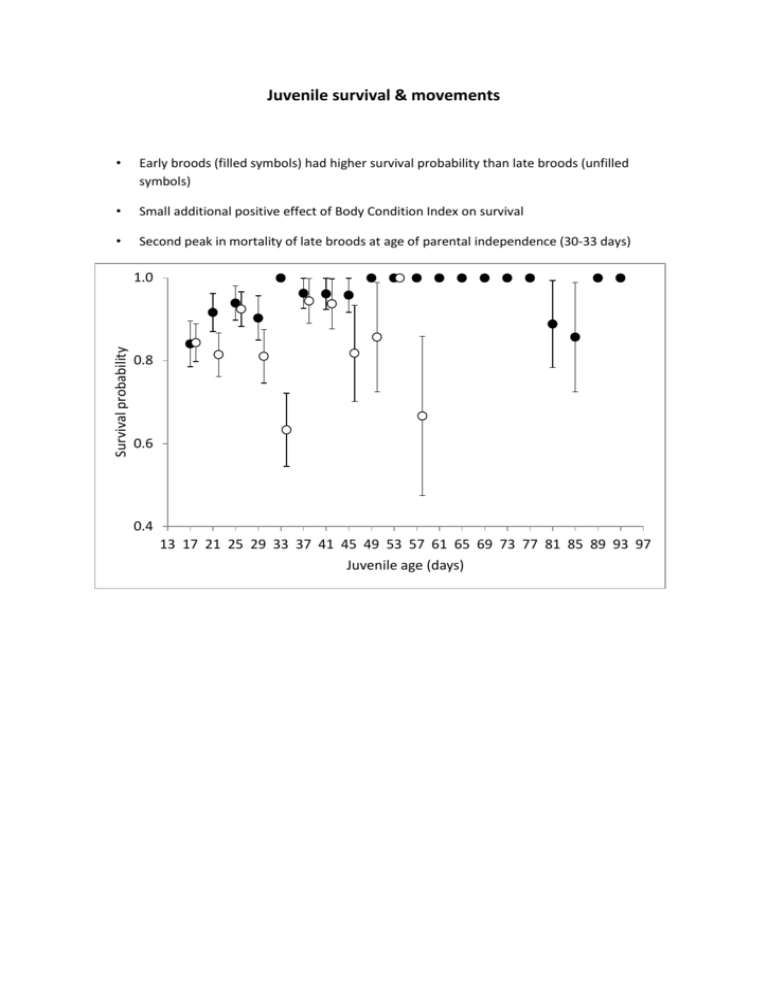Juvenile survival and foraging - 2010 (338kb docx)
advertisement

Juvenile survival & movements • Early broods (filled symbols) had higher survival probability than late broods (unfilled symbols) • Small additional positive effect of Body Condition Index on survival • Second peak in mortality of late broods at age of parental independence (30-33 days) Survival probability 1.0 0.8 0.6 0.4 13 17 21 25 29 33 37 41 45 49 53 57 61 65 69 73 77 81 85 89 93 97 Juvenile age (days) Predation by raptors & mammals was the main cause of death Predators • The majority (30) of deaths caused by raptors could not be attributed to a specific species • However, the remains of 8, 3 and 1 juveniles and/or their radio tags were found in, or within 100m of, buzzard, kestrel & sparrowhawk nests, respectively • None of the 19 deaths caused by mammals could be attributed to a specific species • However, the most likely mammalian predators were stoat and weasel, both of which were regularly seen during the study • Predation by mammals (filled bars) occurs early on in the post-fledging period • Raptors (unfilled bars) take more juveniles when they become more mobile • Both early (filled) & late (unfilled) brood juveniles moved increasingly far from their nests as they aged • Individuals with a higher BCI remained closer to their nests during the period when they were dependent on their parents Median distance from nest (m) 6000 5000 4000 3000 2000 1000 0 14 18 22 26 30 34 38 42 46 50 54 58 62 66 70 74 78 82 86 90 94 Juvenile age (days) Dispersal • Median age at dispersal outside the study area was 71 (range 37-99, n=21) and 44 (range 3881, n=12) days for early and late brood juveniles, respectively • Late brood juveniles dispersed out of the study area at a significantly earlier age than early brood juveniles • Probably reflects the need of late brood juveniles to commence their southward migration at an earlier age than early brood juveniles Juvenile foraging behaviour Study design • Beale et al. (2006) suggested that long-term declines in southern Scotland were associated with high late summer (June-August) UK temperatures and intermediate rainfall levels • So, warmer summers may reduce soil moisture content, and therefore availability of key invertebrate prey, particularly earthworms, which are a key food of ring ouzels during the breeding season • Additionally, the availability of ripe blaeberries, an important late summer pre-migratory food source for ouzels, is lowest when late summer temperatures are high and rainfall is low (Selås 2000) • In 2006, we followed a sample of radio-tagged juveniles through the season to look at broad habitat selection • Showed that birds initially foraged for invertebrates on grass/grass-heather mosaics (invert. plots), then switched to forage on blaeberries & crowberries (berry plots) later on • In 2007-08 we set up a series of invert. & berry ‘control’ plots, to compare the seasonal change in key attributes on these with foraging plots in the same 2 categories • Earthworm biomass stayed constant on control (unfilled) plots in both years • In 2007 earthworm biomass was higher on foraging (filled) plots • In 2008 earthworm biomass increased with date on foraging plots 2007 2008 • Soil moisture content increased with date on control plots in both years • Soil moisture content was higher on control than on foraging plots in 2007 2007 2008 • Vegetation height on control plots increased as the season progressed in both years • In contrast it declined with season on the plots used by foraging ouzels 2007 2008 • Proportion of grass on foraging plots increased with date in 2007 (open symbols) and 2008 (filled symbols) • The abundance of ripe blaeberries on foraging and control plots increased to a peak in late July/early August in both years, followed by a decrease • The abundance of ripe blaeberries was significantly higher on foraging than on control plots in both years, and was significantly lower in 2007 than in 2008 2007 2008 • The abundance of ripe crowberries on foraging and control plots increased to a peak in late July/early August, followed by a decrease in both years • The abundance of ripe crowberries was significantly higher on foraging than on control plots in 2007, but there was no difference in the abundance of ripe crowberries between plot type in 2008 2007 2008 Summary of foraging behaviour • Juveniles initially fed on invertebrates in grass-dominated habitats, then switched to forage on berries later in the season • No evidence of soil drying out, or an associated decline in earthworm biomass • Juveniles selected increasingly grassier plots, with shorter vegetation height, as the season progressed • No evidence for a shortage of moorland berries to fuel migration • However, 2007 very wet & 2008 ‘averagely’ wet, so any detrimental effects of warm, dry summers may not have been apparent





